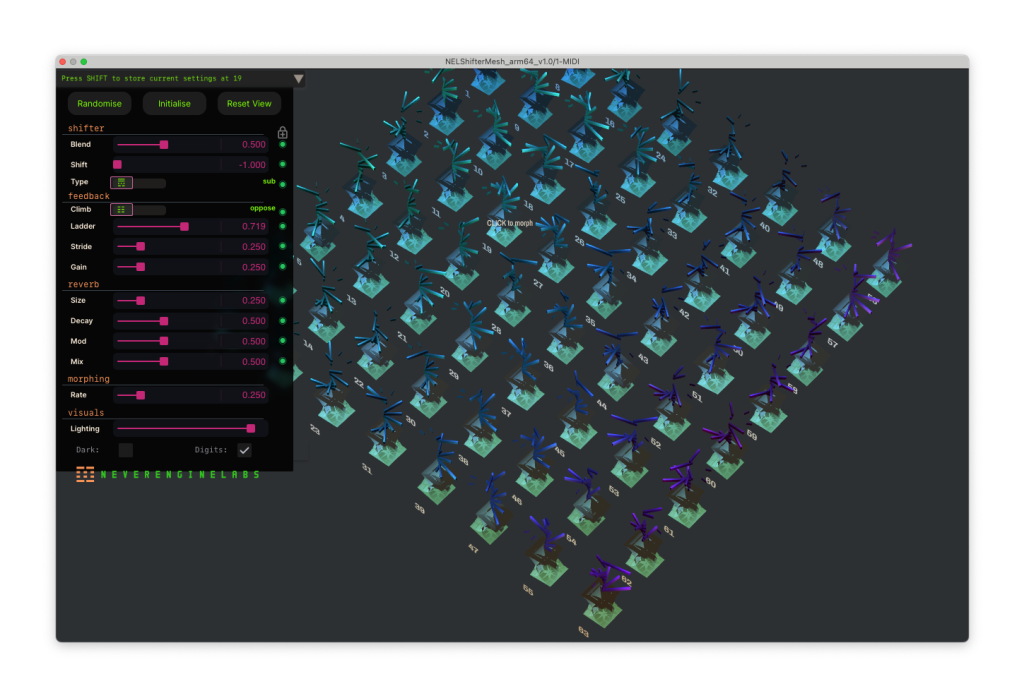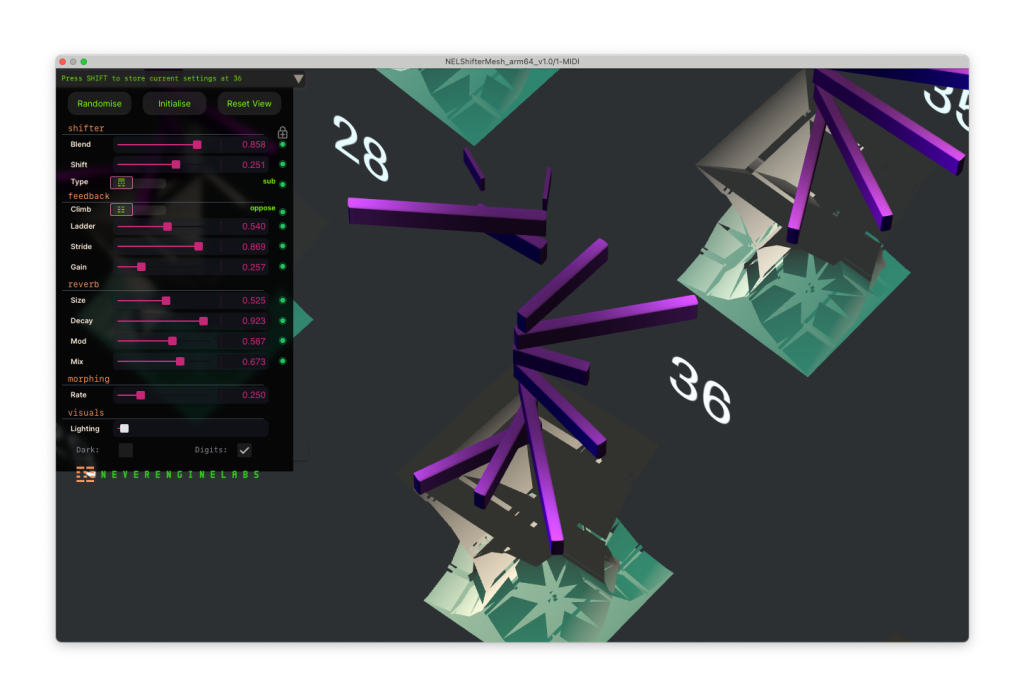We’ve got ancient Chilean trees, a serial/parallel frequency shifter effect combined with a rich reverb, and a tool you can try in your browser as well as in plug-in form. Let’s talk to acclaimed composer Cristian Vogel about the art and code of NEL ShifterMesh.

It’s worth playing with Neverending Labs’ ShifterMesh even before you know exactly what’s going on: simply put, it’s a trip. As geometric abstract trees coil and morph in balletic coils, sounds feed back on themselves into chains of reverberation and resonance.
Cristian Vogel’s music has long been well-loved by fans of bleeding-edge experimentations and ear-bending sonic imagination. But his software creations had largely been the domain of Kyma users – meaning people needed to own special hardware. Now, you can try NEL ShifterMesh in any VST plug-in host on Mac or Windows – or even trial-run it in your web browser for free.
Behind the slightly hallucinogenic UI, you have two stereo effects running both in parallel and series. The titular Frequency Shifter network here is the main draw; it’s a carefully tuned, low-latency pitch shifter network with feedback. There’s internal drive and through-zero shifting, and you can adjust both the shift itself and the feedback, with unique “ladder” feedback you can move into different directions and behaviors.
That on its own would probably be enough of a selling point, but Cristian has also baked in a lush algorithmic reverb, which you can use in subtle ways or to drench the feedback network with layered sounds to make luscious drones and ambient sounds.
And then there’s that UI. The nodes you see each store a snapshot of the parameters gathered into a “forest” of possibilities (with a handy randomize function for the indecisive). Click between those nodes, and you morph from sound to sound – which can produce epic, sweeping sounds, especially with the ladder feedback and reverb in the mix. The morphing time is adjustable, as well. (The lighting is purely aesthetic.) Watch as I play with the superb Oberheim SEM from GForce, and imagine you’re in some fancy studio in Paris with a SEM and a Kyma, basically, except … you can do this in a browser!
First, what’s the essential idea of Shifter Mesh? How did you first come to this concept?
ShifterMesh is a painstakingly designed multi-effects processor, which also features an innovative approach on the viewable controller side. Technically, the work is presented in the form of a native VST plugin for Windows and Mac and a web-based interactive app that can run in any browser. I believe this puts it in an interesting position as a sound-based product, where its potential reach is wider on a global
scale than that of an album. As a sound-based artist, this is one of the motivations behind the challenge. How can I connect my auditory design thinking and creative approach to as many minds as possible? How can I do that in a global – yet intimate way – whilst sidestepping the corporate-biased ‘music industry’ of today? How can I do that in an economically viable way?
Some readers will know you from your music. How did your musical work relate to the creation of this plug-in? Have we heard it in your work yet – or might we?
Close listeners of my recorded works would have definitely heard pitch and frequency shifts and all sorts of radical spectral and spatial alteration, such as spectral stretching, smearing, and shifting. So, when thinking about a constellation of effects that always inspire me and accepting where the limits of my technical abilities lie in terms of programming them myself – it came down to designing an effects processor built around the following three elements.
- High-quality full-range frequency shifting – spectral
- Shifted and delayed feedback networks – time-based
- High-quality reverb – spatial
Close listeners of my recorded works would have definitely heard pitch and frequency shifts and all sorts of radical spectral and spatial alteration.
It’s always a dilemma in a way, being an artist and a toolmaker – you’re creating something for people who may have very different compositional ideas. How do you view the connection (or distance) between the two?
Well, that’s a very good point. It’s a bit like what writers have to think about in literature, and I approach it in a similar way. I focus on using a stylized set of creative skills honed from decades of practice – primarily the ear and the unique cognitive associations between sound, mapping, and implementation. If I use these skills to create a tool for others, then that tool should be capable of generating meaning for other creators in precise or oblique ways. At that point, it’s not up to me anymore.
You’re obviously known in the world of Kyma, too. [Kyma is a dedicated DSP hardware/software environment.] Where does Shifter Mesh fit in your other technological productions? How does it connect to those creations, or was it inspired by Kyma work you’d done? (I think this is actually your first plug-in, per se?)
Indeed, it is my first sound design tool outside of the Kyma specialized system. The Kyma community and system are wonderful, and they’ve been a great support over the past few decades. Kyma, to me, still remains very relevant and is an excellent environment to prototype and keep pushing further in terms of innovation in digital sound design. In that way it is similar to other platforms – Max, Reaktor, SuperCollider. However, one of its limitations is that those designs cannot be easily ported to other targets, like VST, embedded, or WebAssembly. My drive in recent years has been to try to get my sound design work out to a wider audience. Until now, I have done that by releasing studio recordings and live performance work. But since the pandemic, being a recording and performing artist has simply become unsustainable for me. I can barely pay the bills. A huge problem for many others, too.

You made use of some open-source frameworks, right? Can you talk about any of those?
Yes, thanks! The open source and FOSS communities on the web are a huge inspiration to me.
I learn everything from the code-based communities around them. I feel a great sense of solidarity with open-source developers and users—something I miss from the music scene, actually. Before streaming and MP3 broke everything, we used to have a much stronger community connection between musicians and producers than we have now. I see some echoes of that in the open-source world.
What was the journey between plug-in and Web versions, specifically? Any lessons learned? (Are there any Web technologies in the plug-in version, too?)
I wanted to try to present the end product completely differently from the typical video walkthrough. In the end, the video will be on YouTube, and that’s back into the exploitative corporate mire again. Thanks to the awesome Elementary Audio project, which is the backbone of the DSP part, and its potential for being wired into C++ tooling, like Tracktion CHOC, I realized that a live web demo was within reach! Amazingly, I achieved it, which was a major milestone for me. Apparently, I am part of the first wave to have achieved this – a near identical audio product running as both native VST and native browser-based targets. It was challenging and messy, a bit like taking a BMX and transforming it into a Megatron.
How are the mesh and the sonic parameters interrelated? Was this unique to you, taking the geometry and engine values together?
Yeah, so the other super-cool thing is that ShifterMesh is running a web view front end. This means I could apply my last 5 years of re-training as a front-end developer to help me write the user interface. It’s all written in Svelte (TypeScript) and Threlte, which is a Svelte library wrapping the excellent Three.js library for WebGL graphics. It meant I could come up with something really interesting for the UI…. I meditated a long time on the possibilities of 3D graphics for audio UI, messed around in cables.gl a lot, and began to draw similarities between parametric geometries and parametric sound design. I saw that a geometry could express structurally the settings of the sound-altering parameters. After some months of experimentation, I came up with the idea of the interpolating mesh of geometries, where each
‘tree’ instance in the 3D mesh holds a preset, and users can morph all the parameters at once by clicking
I saw that a geometry could express structurally the settings of the sound-altering parameters.
Can you talk a bit about the tree? I see it in the twisting form, of course, but how did this
come about – from what I could gather, via a trip to Chile?
You are correct. I went back to Chile in May 2024, and it was a phenomenal trip for me, so many cool things that I will remember for always. I met an amazing collective in Santiago (FoMo, Pueblo Nuevo and Grieta) who produced a highly successful concert evening for me lasting many hours. (I hadn’t been back for 24 years!)This event and the reception I received was truly nourishing for my artistic confidence after a grueling period of hardship in the fad-led European scene. For the record, I still have not been booked to play in Europe since 2020, and it was beginning to seem pretty bleak for my career. Hence, the 5-week trip to Chile was a breath of fresh air. It was so great to see such a massive respect for pioneers of electronic music over there.
Of great significance to me, too, was a trip I took to the Conguillio National Park in Patagonia with my cousin and my sister. I was absolutely stunned by the magnificence and scales of the natural landscapes and forests of ancient Araucaria trees, all with a backdrop of huge volcanoes. We experienced snowfall, thick fog, and 30-degree sun in a short period of days there, all in the presence of the most friendly and welcoming trees – and no phone or social media or any traces of bars, cafes, souvenir shops, or any of that crap. In Europe, some colonial idiot named the majestic ARAUCARIA ARAUCANA tree as the Monkey Puzzle tree, which is pretty ignorant because there aren’t even any native monkeys in Chile.
Ed.: Here’s some more background on the trees and the indigenous struggle to protect them:
Thanks so much, Cristian! I feel I have more to explore both in JavaScript and … trees. Not necessarily in that order. So in addition to checking the plug-in, you can follow some of Cristian’s music online easily:
Test the software and find more information at the product page:
https://neverenginelabs.com/products/nel-shiftmesh




